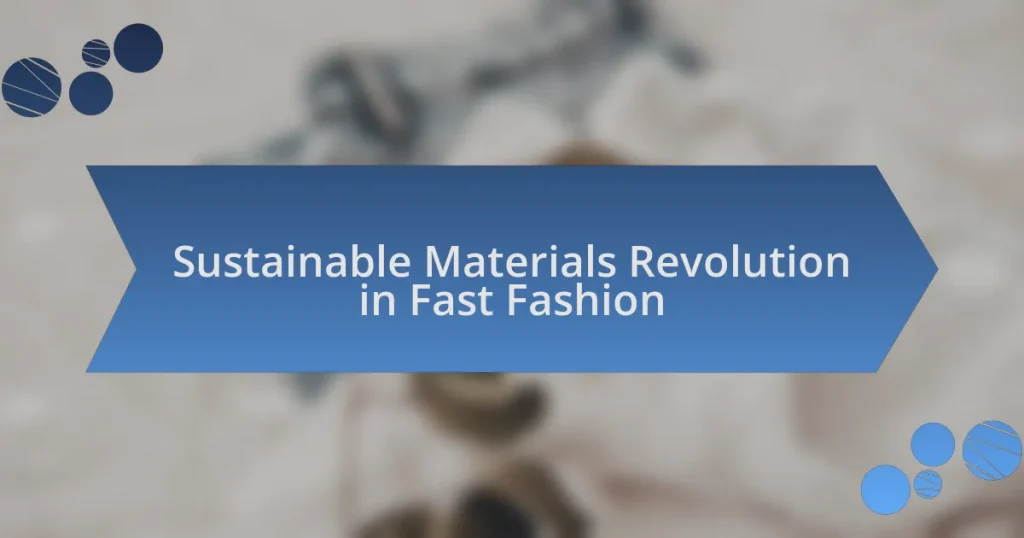The Sustainable Materials Revolution in Fast Fashion represents a significant shift towards the use of eco-friendly, renewable, and recycled materials in clothing production to mitigate the environmental impact of traditional fast fashion practices. This article explores the characteristics of sustainable materials, their differences from conventional fabrics, and the importance of this revolution for the fashion industry. It also addresses the challenges faced in adopting sustainable practices, the role of consumer demand, and the future trends shaping this movement. Key sustainable materials such as organic cotton, recycled polyester, and Tencel are highlighted, along with the impact of technology and consumer behavior on promoting sustainability in fashion.

What is the Sustainable Materials Revolution in Fast Fashion?
The Sustainable Materials Revolution in Fast Fashion refers to the shift towards using eco-friendly, renewable, and recycled materials in the production of clothing to reduce environmental impact. This revolution aims to address the significant waste and pollution generated by traditional fast fashion practices, which often rely on synthetic materials and unsustainable production methods. For instance, the use of organic cotton, Tencel, and recycled polyester has been increasing, as these materials require less water and energy and produce fewer greenhouse gas emissions compared to conventional fabrics. According to a report by McKinsey & Company, sustainable materials could reduce the fashion industry’s greenhouse gas emissions by 44% by 2030, highlighting the potential impact of this revolution on climate change and resource conservation.
How is the Sustainable Materials Revolution defined within the context of fast fashion?
The Sustainable Materials Revolution within the context of fast fashion is defined as a transformative shift towards the use of eco-friendly, renewable, and recycled materials in clothing production to reduce environmental impact. This revolution aims to address the significant waste and pollution generated by the fast fashion industry, which is responsible for approximately 10% of global carbon emissions and substantial water usage. By prioritizing sustainable materials, brands can minimize resource depletion and promote circular economy practices, thereby contributing to a more sustainable fashion ecosystem.
What are the key characteristics of sustainable materials in fashion?
Sustainable materials in fashion are characterized by their environmental friendliness, resource efficiency, and social responsibility. These materials are often derived from renewable resources, such as organic cotton or recycled polyester, which minimize the depletion of natural resources. Additionally, they are produced using processes that reduce water consumption and chemical usage, thereby lowering their ecological footprint. For instance, organic cotton uses 91% less water than conventional cotton, according to the World Wildlife Fund. Furthermore, sustainable materials often prioritize fair labor practices, ensuring that workers are treated ethically and compensated fairly, which aligns with the principles of social sustainability.
How do sustainable materials differ from traditional materials used in fast fashion?
Sustainable materials differ from traditional materials used in fast fashion primarily in their environmental impact and sourcing practices. Traditional materials, such as polyester and cotton, often rely on petroleum-based resources and involve harmful chemical processes, contributing to pollution and resource depletion. In contrast, sustainable materials, like organic cotton, Tencel, and recycled polyester, are produced with a focus on reducing environmental harm, utilizing renewable resources, and minimizing waste. For instance, organic cotton is grown without synthetic pesticides, which protects ecosystems, while recycled polyester repurposes plastic waste, reducing landfill contributions. These differences highlight the commitment of sustainable materials to ecological responsibility and resource conservation, contrasting sharply with the practices prevalent in fast fashion.
Why is the Sustainable Materials Revolution important for the fashion industry?
The Sustainable Materials Revolution is crucial for the fashion industry because it addresses the environmental and social impacts of traditional textile production. This revolution promotes the use of eco-friendly materials, which significantly reduce waste, pollution, and carbon emissions associated with conventional fashion practices. For instance, the Ellen MacArthur Foundation reports that the fashion industry is responsible for 10% of global carbon emissions, highlighting the urgent need for sustainable alternatives. By adopting sustainable materials, brands can enhance their environmental responsibility, meet consumer demand for ethical products, and contribute to a circular economy, ultimately leading to a more sustainable future for the industry.
What environmental impacts does fast fashion have that sustainable materials aim to mitigate?
Fast fashion significantly contributes to environmental degradation through excessive waste generation, high carbon emissions, and water pollution. Sustainable materials aim to mitigate these impacts by promoting eco-friendly production processes, reducing resource consumption, and minimizing landfill contributions. For instance, the fashion industry is responsible for 10% of global carbon emissions, and sustainable practices can lower this by utilizing renewable resources and reducing energy use. Additionally, fast fashion generates approximately 92 million tons of textile waste annually, while sustainable materials encourage recycling and upcycling, thus decreasing landfill overflow. Furthermore, the dyeing and finishing processes in fast fashion often pollute water sources, but sustainable materials utilize non-toxic dyes and water-efficient techniques to lessen this pollution.
How does consumer demand influence the shift towards sustainable materials?
Consumer demand significantly influences the shift towards sustainable materials by driving brands to adopt eco-friendly practices in response to consumer preferences. As awareness of environmental issues grows, consumers increasingly prioritize sustainability in their purchasing decisions, leading to a higher demand for products made from sustainable materials. For instance, a 2021 survey by McKinsey found that 67% of consumers consider sustainability when making a purchase, prompting brands in the fast fashion industry to innovate and incorporate sustainable materials like organic cotton and recycled polyester into their collections. This shift not only aligns with consumer values but also enhances brand loyalty and market competitiveness, as companies that fail to adapt risk losing market share to more environmentally conscious competitors.
What challenges does the Sustainable Materials Revolution face in fast fashion?
The Sustainable Materials Revolution faces significant challenges in fast fashion, primarily due to the industry’s inherent focus on rapid production and low-cost materials. Fast fashion brands prioritize quick turnaround times and affordability, which often leads to the use of cheap, non-sustainable materials that are detrimental to the environment. For instance, the global fast fashion market is projected to reach $102.5 billion by 2025, indicating a growing demand that conflicts with sustainable practices. Additionally, the lack of consumer awareness and demand for sustainable options further complicates the transition, as many consumers prioritize price and trend over sustainability. This creates a cycle where sustainable materials struggle to compete in a market driven by speed and cost, hindering the overall effectiveness of the Sustainable Materials Revolution in this sector.
What are the economic barriers to adopting sustainable materials in fast fashion?
The economic barriers to adopting sustainable materials in fast fashion include higher production costs, limited availability of sustainable materials, and consumer price sensitivity. Fast fashion brands often prioritize low-cost production to maximize profit margins, making it challenging to integrate more expensive sustainable materials. For instance, organic cotton can cost up to 20% more than conventional cotton, which impacts overall pricing strategies. Additionally, the supply chain for sustainable materials is not as developed, leading to inconsistent availability and increased costs. Consumer demand for low prices further complicates the situation, as many shoppers are unwilling to pay a premium for sustainable options, thereby discouraging brands from investing in sustainable materials.
How do supply chain complexities affect the implementation of sustainable materials?
Supply chain complexities significantly hinder the implementation of sustainable materials in fast fashion by introducing challenges such as coordination, transparency, and resource allocation. These complexities arise from the intricate networks of suppliers, manufacturers, and logistics providers involved in the production process. For instance, a study by the Ellen MacArthur Foundation highlights that the fast fashion industry often relies on a fragmented supply chain, making it difficult to trace the origin and sustainability of materials used. This lack of transparency can lead to the use of non-sustainable materials, as brands may struggle to verify their suppliers’ practices. Additionally, the rapid pace of production in fast fashion creates pressure to prioritize speed over sustainability, further complicating the integration of eco-friendly materials.
How can brands effectively transition to sustainable materials?
Brands can effectively transition to sustainable materials by adopting a comprehensive strategy that includes sourcing eco-friendly materials, investing in technology for sustainable production, and engaging in transparent supply chain practices. For instance, brands can utilize organic cotton, recycled polyester, and biodegradable fabrics, which have been shown to reduce environmental impact significantly. According to a report by McKinsey & Company, the fashion industry could reduce its greenhouse gas emissions by 1.1 billion tons annually by shifting to sustainable materials. Additionally, brands should collaborate with suppliers who prioritize sustainability and invest in research and development to innovate new materials. This approach not only enhances brand reputation but also meets the growing consumer demand for environmentally responsible products.
What role do consumers play in promoting the Sustainable Materials Revolution?
Consumers play a crucial role in promoting the Sustainable Materials Revolution by driving demand for eco-friendly products and influencing brands to adopt sustainable practices. Their purchasing choices directly impact the market, as evidenced by a 2021 survey indicating that 66% of global consumers are willing to pay more for sustainable brands. This consumer behavior encourages companies in the fast fashion industry to prioritize sustainable materials and ethical production methods, thereby fostering a shift towards more responsible consumption and production patterns.

What types of sustainable materials are being utilized in fast fashion?
Fast fashion brands are increasingly utilizing sustainable materials such as organic cotton, recycled polyester, Tencel, and hemp. Organic cotton is grown without synthetic pesticides and fertilizers, reducing environmental impact. Recycled polyester, made from post-consumer plastic bottles, diverts waste from landfills and decreases reliance on virgin materials. Tencel, derived from sustainably sourced wood pulp, is produced in a closed-loop process that minimizes water and chemical use. Hemp is a fast-growing crop that requires fewer resources and can improve soil health. These materials contribute to reducing the carbon footprint and promoting eco-friendly practices in the fast fashion industry.
What are the most common sustainable materials used in the industry?
The most common sustainable materials used in the industry include organic cotton, recycled polyester, Tencel (lyocell), hemp, and bamboo. Organic cotton is grown without synthetic pesticides or fertilizers, reducing environmental impact. Recycled polyester, made from post-consumer plastic bottles, diverts waste from landfills and reduces reliance on virgin petroleum. Tencel, derived from sustainably sourced wood pulp, is produced in a closed-loop process that minimizes water and chemical use. Hemp is a fast-growing crop that requires little water and no pesticides, making it an eco-friendly alternative. Bamboo grows rapidly and can be cultivated without harmful chemicals, contributing to its sustainability. These materials are increasingly adopted in the fast fashion industry to address environmental concerns and promote sustainable practices.
How are natural fibers contributing to sustainability in fast fashion?
Natural fibers contribute to sustainability in fast fashion by offering biodegradable alternatives to synthetic materials, which often pollute the environment. These fibers, such as organic cotton, linen, and hemp, require less water and fewer chemicals during cultivation compared to conventional fibers. For instance, organic cotton uses 91% less water than conventional cotton, significantly reducing water waste. Additionally, natural fibers are renewable resources, as they can be regrown, unlike petroleum-based synthetics. This shift towards natural fibers can decrease the carbon footprint of the fashion industry, which is responsible for 10% of global carbon emissions. By integrating natural fibers, fast fashion brands can enhance their sustainability efforts and reduce their environmental impact.
What innovations in synthetic materials are being developed for sustainability?
Innovations in synthetic materials for sustainability include bio-based polymers, recycled polyester, and biodegradable plastics. Bio-based polymers, derived from renewable resources like corn or sugarcane, reduce reliance on fossil fuels and lower carbon emissions. Recycled polyester, made from post-consumer plastic bottles, diverts waste from landfills and decreases the need for virgin materials, thus conserving resources. Biodegradable plastics, designed to break down more quickly in the environment, mitigate long-term pollution. According to a report by the Ellen MacArthur Foundation, transitioning to these sustainable synthetic materials can significantly reduce the environmental impact of the fashion industry, highlighting the importance of innovation in achieving sustainability goals.
How do these materials impact the lifecycle of fashion products?
Sustainable materials significantly enhance the lifecycle of fashion products by reducing environmental impact and promoting circularity. These materials, such as organic cotton, recycled polyester, and Tencel, contribute to lower carbon emissions and water usage during production compared to conventional materials. For instance, organic cotton uses 91% less water than traditional cotton farming, which directly influences the sustainability of the product lifecycle. Furthermore, the use of recycled materials helps divert waste from landfills, thereby extending the lifecycle of fashion products by enabling recycling and reuse. Studies indicate that adopting sustainable materials can reduce the overall environmental footprint of the fashion industry by up to 30%, demonstrating their critical role in fostering a more sustainable fashion ecosystem.
What are the benefits of using biodegradable materials in fast fashion?
The benefits of using biodegradable materials in fast fashion include reduced environmental impact, improved waste management, and enhanced brand reputation. Biodegradable materials decompose naturally, minimizing landfill waste and pollution compared to traditional synthetic fabrics, which can take hundreds of years to break down. For instance, a study by the Ellen MacArthur Foundation highlights that transitioning to biodegradable materials can significantly decrease the fashion industry’s carbon footprint. Additionally, brands adopting these materials can attract environmentally conscious consumers, thereby enhancing their market position and brand loyalty.
How do recycled materials contribute to sustainability efforts?
Recycled materials significantly contribute to sustainability efforts by reducing the demand for virgin resources and minimizing waste. By reusing materials, industries can lower energy consumption and greenhouse gas emissions associated with the extraction and processing of new raw materials. For instance, recycling one ton of plastic can save up to 1,000-2,000 gallons of gasoline, demonstrating a substantial reduction in fossil fuel usage. Additionally, using recycled fibers in textiles can decrease water usage by up to 90% compared to producing new fibers. This shift not only conserves natural resources but also promotes a circular economy, where materials are kept in use for as long as possible, thereby reducing environmental impact.

What are the future trends in the Sustainable Materials Revolution in fast fashion?
The future trends in the Sustainable Materials Revolution in fast fashion include the increased use of bio-based materials, circular economy practices, and advanced recycling technologies. Bio-based materials, such as those derived from agricultural waste or algae, are gaining traction as brands seek to reduce their reliance on petroleum-based fabrics. Circular economy practices, which emphasize the reuse and recycling of garments, are becoming essential as companies aim to minimize waste and extend product life cycles. Advanced recycling technologies, including chemical recycling, are being developed to convert post-consumer textiles back into raw materials, thereby closing the loop in the fashion supply chain. These trends are supported by growing consumer demand for sustainability, regulatory pressures, and innovations in material science, indicating a significant shift towards more sustainable practices in the fast fashion industry.
How is technology shaping the future of sustainable materials in fashion?
Technology is significantly shaping the future of sustainable materials in fashion by enabling the development of innovative, eco-friendly textiles and production processes. Advanced technologies such as 3D printing and biofabrication allow designers to create materials from renewable resources, reducing reliance on petroleum-based fabrics. For instance, companies like Bolt Threads are producing mycelium-based leather alternatives, which have a lower environmental impact compared to traditional leather production. Additionally, digital textile printing minimizes waste by allowing for on-demand production, thus reducing excess inventory and resource consumption. These technological advancements not only enhance sustainability but also promote circular fashion practices, as seen in the rise of recycling technologies that convert post-consumer waste into new fibers.
What advancements in material science are on the horizon?
Advancements in material science on the horizon include the development of bio-based and biodegradable textiles, which aim to reduce environmental impact in the fast fashion industry. Researchers are focusing on creating fabrics from renewable resources, such as algae and agricultural waste, which can decompose naturally, thus minimizing landfill waste. For instance, a study published in the journal “Nature Sustainability” highlights innovations in using mycelium, the root structure of mushrooms, to produce sustainable leather alternatives. These advancements not only address sustainability but also enhance the performance characteristics of materials, such as durability and moisture-wicking properties, making them suitable for consumer demands in fast fashion.
How are digital tools influencing sustainable practices in fast fashion?
Digital tools are significantly influencing sustainable practices in fast fashion by enabling better supply chain transparency and facilitating data-driven decision-making. Technologies such as blockchain provide traceability of materials, allowing brands to verify the sustainability of their sources, which is crucial for reducing environmental impact. Additionally, data analytics tools help companies optimize inventory management, reducing waste by aligning production with actual consumer demand. For instance, a study by McKinsey & Company highlights that digital technologies can reduce waste in the fashion industry by up to 30% through improved forecasting and inventory practices. This integration of digital tools not only enhances operational efficiency but also promotes accountability and sustainability within the fast fashion sector.
What are the potential impacts of the Sustainable Materials Revolution on consumer behavior?
The Sustainable Materials Revolution is likely to significantly alter consumer behavior by increasing demand for eco-friendly products and promoting sustainable purchasing habits. As consumers become more aware of environmental issues, they are more inclined to choose brands that prioritize sustainability, leading to a shift in market dynamics. Research indicates that 66% of global consumers are willing to pay more for sustainable brands, highlighting a growing preference for products made from sustainable materials. This shift not only influences individual purchasing decisions but also pressures companies in the fast fashion industry to adopt sustainable practices to meet consumer expectations.
How can education and awareness drive consumer choices towards sustainability?
Education and awareness can significantly drive consumer choices towards sustainability by informing individuals about the environmental impacts of their purchasing decisions. When consumers understand the consequences of fast fashion, such as pollution and resource depletion, they are more likely to choose sustainable alternatives. Research indicates that 66% of global consumers are willing to pay more for sustainable brands, highlighting the influence of awareness on purchasing behavior. Furthermore, educational initiatives, such as campaigns and workshops, can empower consumers with knowledge about sustainable materials and ethical practices, leading to more informed choices that support sustainable fashion.
What role do social media and influencers play in promoting sustainable fashion?
Social media and influencers play a crucial role in promoting sustainable fashion by amplifying awareness and driving consumer engagement. Influencers leverage their platforms to showcase sustainable brands, educate followers about eco-friendly practices, and encourage responsible consumption. For instance, a study by the Global Fashion Agenda found that 62% of consumers are more likely to purchase from brands that are endorsed by influencers who advocate for sustainability. This demonstrates that influencers can effectively shift consumer behavior towards more sustainable choices in fashion.
What practical steps can consumers take to support the Sustainable Materials Revolution?
Consumers can support the Sustainable Materials Revolution by choosing products made from sustainable materials, such as organic cotton, recycled polyester, and Tencel. By prioritizing these materials, consumers reduce the demand for conventional textiles that often rely on harmful chemicals and unsustainable practices. Research indicates that organic cotton uses 91% less water than conventional cotton, highlighting the environmental benefits of sustainable choices. Additionally, consumers can support brands that are transparent about their supply chains and commit to ethical production practices, which fosters accountability in the fast fashion industry. Engaging in second-hand shopping and clothing swaps further minimizes waste and extends the lifecycle of garments, contributing to a circular economy.















